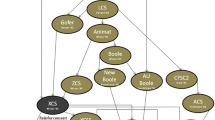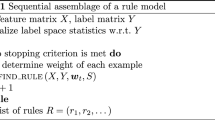Summary
BYPASS is a rule-based learning algorithm designed loosely after John Holland’s Classifier System (CS) idea. In essence, CSs are incremental data processors that attempt to (self-)organize a population of rules under the guidance of certain reinforcement policy. BYPASS uses a reinforcement scheme based on predictive scoring and handles conditions similar to those in standard classification trees. However, these conditions are allowed to overlap; this makes it possible to base individual predictions on several rules (just like in committees of trees). Moreover, conditions are supplied with simple bayesian predictive distributions that evolve as data are processed. The paper presents the details of the algorithm and discusses empirical results suggesting that statistical and reinforcement-based learning blend together in interesting and useful ways.



Similar content being viewed by others
5 References
Breiman, L. (1996). Bagging Predictors. Machine Learning 24, 123–140.
Breiman, L., Friedman, J. H., Olshen, R. A. and Stone, C. J. (1984). Classiffication and Regression Trees. Pacific Grove, CA: Wadsworth.
Butz, M. V., Goldberg, D. E., and Stolzmann, W. (2000). The Anticipatory Classifier System and Genetic Generalization. Technical Report 2000032, Illinois Genetic Algorithms Laboratory, University of Illinois at Urbana-Champaign.
Chipman, H., George, E., and McCulloch, R. (1998). Bayesian CART Model Search. Journal of the American Statistical Association 93, 935–960.
De Jong, K. A., Spears, W. M. and Gordon, D. F. (1993). Using Genetic Algorithms for Concept Learning. Machine Learning 13, 161–188.
Denison, D. G. T., Adams, N. M., Holmes, C. C. and Hand, D. J. (2000). Bayesian Partition Modelling. Preprint available at http://stats.ma.ic.ac.uk/~dgtd/tech.html
Freitas, A. A. (Ed.) (1999). Data Mining with Evolutionary Algorithms: Research Directions. Proceedings of the AAAI-99 & GECCO-99 Workshop on Data Mining with Evolutionary Algorithms. Technical Report WS-99-06. A.A.A.I. Press.
Frey, P. W. and Slate, D. J. (1991). Letter Recognition Using Holland-style Adaptive Classifiers. Machine Learning 6, 161–182.
Goldberg, D. E. (1989). Genetic Algorithms in Search, Optimization, and Machine Learning. Reading, MA: Addison-Wesley.
Hand, D. J. (1997). Construction and Assessment of Classification Rules. New York: John Wiley.
Holland, J. H., Holyoak, K. J., Nisbett, R. E. and Thagard, P. R. (1986). Induction: Processes of Inference, Learning and Discovery. Cambridge, MA: M.I.T. Press.
Lanzi, P. L., Stolzmann, W. and Wilson, S. W. (Eds.) (2000). Learning Classifier Systems. Berlin: Springer-Verlag.
Michie, D., Spiegelhalter, D. J. and Taylor, C. C. (1994). Machine Learning, Neural and Statistical Classification. New York: Ellis Horwood.
Muruzábal, J. (1995). Fuzzy and Probabilistic Reasoning in Simple Learning Classifier Systems. In Proceedings of the 2nd IEEE International Conference on Evolutionary Computation (Ed. D. B. Fogel), 262–266. Piscataway, NJ: I.E.E.E. Press.
Muruzábal, J. (1999). Mining the Space of Generality with Uncertainty-Concerned, Cooperative Classifiers. In Proceedings of the Genetic and Evolutionary Computation Conference, GECCO-99 (Eds. W. Banzhaf, J. Daida, A. E. Eiben, M. H. Garzon, V. Honavar, M. Jakiela and R. E. Smith), 449–457. San Francisco, CA: Morgan Kaufmann.
Muruzábal, J. and Muñoz, A. (1994). Diffuse Pattern Learning with Fuzzy ARTMAP and PASS. Springer-Verlag Lecture Notes in Computer Science, Vol. 866, 376–385.
Paass, G. and Kindermann, J. (1998). Bayesian Classification Trees with Overlapping Leaves Applied to Credit-Scoring. Springer-Verlag Lecture Notes in Computer Science, Vol. 1394, 234–245.
Tierney, L. (1990). LISP-STAT: An Object-Oriented Environment for Statistical Computing and Dynamic Graphics. New York: John Wiley.
Tukey, J. W. (1985). Discussion of G. J. Hahn’s “More Intelligent Statistical Software and Statistical Expert Systems: Future Directions”. The American Statistician, Vol. 39.
Venables, W. N. and Ripley, B. D. (1997). Modern Applied Statistics with S-PLUS. New York: Springer-Verlag.
Whitehead, B. A. and Choate, T. D. (1996). Cooperative-Competitive Genetic Evolution of Radial Basis Function Centers and Widths for Time Series Prediction. IEEE Transactions on Neural Networks 7(4), 869–880.
Wilson, S. W. (1987). Classifier Systems and the Animat Problem. Machine Learning 2, 199–228.
Wilson, S. W. (1995). Classifier Fitness Based on Accuracy. Evolutionary Computation 3(2), 149–175.
Acknowledgement
Support by CICYT grants HID98-0379-C02-01 and TIC98-0272-C02-01 is appreciated.
Author information
Authors and Affiliations
Corresponding author
Rights and permissions
About this article
Cite this article
Muruzábal, J. Combining statistical and reinforcement learning in rule-based classification. Computational Statistics 16, 341–359 (2001). https://doi.org/10.1007/s001800100071
Published:
Issue Date:
DOI: https://doi.org/10.1007/s001800100071




